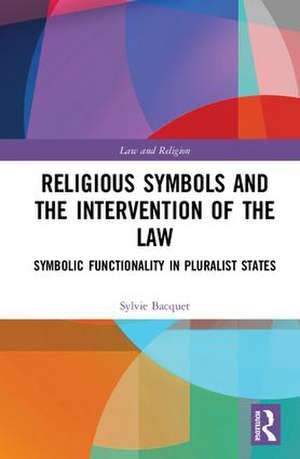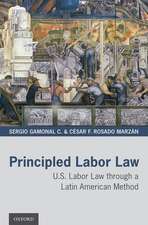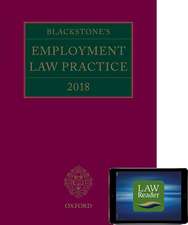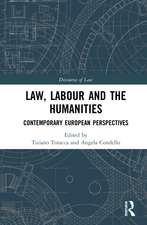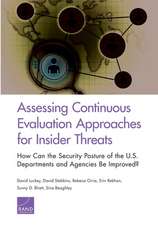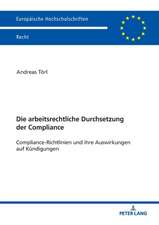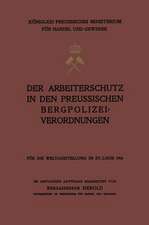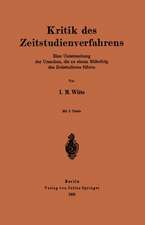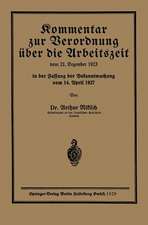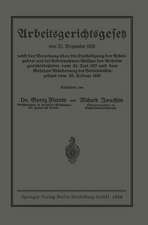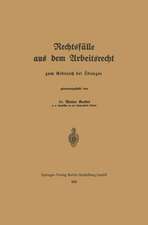Religious Symbols and the Intervention of the Law: Symbolic Functionality in Pluralist States: Law and Religion
Autor Sylvie Bacqueten Limba Engleză Hardback – 25 iun 2019
This book analyses the relationship between the state, individuals and religious symbols, considering the three main forms of religious expression, symbols that believers wear on their body, symbols in the public space such as religious edifices and rituals that believers perform as a manifestation of their faith. The book looks comparatively at legal responses in England, the U.S.A and France comparing different approaches to the issues of symbols in the public sphere and their interaction with the law. The book considers religious manifestation as a social phenomenon taking a multidisciplinary approach to the question mixing elements of the anthropology, history and sociology of religion in order to provide some context and examine how this could help inform the law.
| Toate formatele și edițiile | Preț | Express |
|---|---|---|
| Paperback (1) | 322.05 lei 6-8 săpt. | |
| Taylor & Francis – 31 mar 2021 | 322.05 lei 6-8 săpt. | |
| Hardback (1) | 651.64 lei 6-8 săpt. | |
| Taylor & Francis – 25 iun 2019 | 651.64 lei 6-8 săpt. |
Din seria Law and Religion
-
 Preț: 315.07 lei
Preț: 315.07 lei -
 Preț: 313.47 lei
Preț: 313.47 lei -
 Preț: 310.70 lei
Preț: 310.70 lei -
 Preț: 318.02 lei
Preț: 318.02 lei - 8%
 Preț: 390.17 lei
Preț: 390.17 lei -
 Preț: 311.61 lei
Preț: 311.61 lei -
 Preț: 312.66 lei
Preț: 312.66 lei -
 Preț: 311.56 lei
Preț: 311.56 lei -
 Preț: 378.08 lei
Preț: 378.08 lei -
 Preț: 379.68 lei
Preț: 379.68 lei -
 Preț: 411.17 lei
Preț: 411.17 lei -
 Preț: 389.96 lei
Preț: 389.96 lei -
 Preț: 393.35 lei
Preț: 393.35 lei -
 Preț: 391.40 lei
Preț: 391.40 lei - 18%
 Preț: 1006.11 lei
Preț: 1006.11 lei -
 Preț: 390.63 lei
Preț: 390.63 lei -
 Preț: 384.22 lei
Preț: 384.22 lei - 17%
 Preț: 259.98 lei
Preț: 259.98 lei -
 Preț: 368.59 lei
Preț: 368.59 lei -
 Preț: 416.22 lei
Preț: 416.22 lei -
 Preț: 393.13 lei
Preț: 393.13 lei - 14%
 Preț: 298.58 lei
Preț: 298.58 lei -
 Preț: 466.45 lei
Preț: 466.45 lei -
 Preț: 396.40 lei
Preț: 396.40 lei -
 Preț: 322.05 lei
Preț: 322.05 lei -
 Preț: 390.63 lei
Preț: 390.63 lei -
 Preț: 396.47 lei
Preț: 396.47 lei
Preț: 651.64 lei
Preț vechi: 913.66 lei
-29% Nou
Puncte Express: 977
Preț estimativ în valută:
124.69€ • 130.54$ • 103.17£
124.69€ • 130.54$ • 103.17£
Carte tipărită la comandă
Livrare economică 05-19 aprilie
Preluare comenzi: 021 569.72.76
Specificații
ISBN-13: 9781138953833
ISBN-10: 1138953830
Pagini: 182
Dimensiuni: 156 x 234 x 12 mm
Greutate: 0.39 kg
Ediția:1
Editura: Taylor & Francis
Colecția Routledge
Seria Law and Religion
Locul publicării:Oxford, United Kingdom
ISBN-10: 1138953830
Pagini: 182
Dimensiuni: 156 x 234 x 12 mm
Greutate: 0.39 kg
Ediția:1
Editura: Taylor & Francis
Colecția Routledge
Seria Law and Religion
Locul publicării:Oxford, United Kingdom
Public țintă
Postgraduate and UndergraduateCuprins
Foreword by Santiago Canamares
Part I: Religious Symbols in a Socio-Historical Context
1 Introduction
2 A multidisciplinary approach to the definition of religious manifestation
3 Historical origin and significance of religious symbols
4 Religious symbols and identity in contemporary pluralist states
Part II: Religious Symbols and the Law in 21st Century Pluralist States: country approaches
5 France and Laïcité
6 England and the Established Church
7 The United States and Tolerant Neutrality
Part III: The Future of Religious Symbols and The Law in 21st Century Pluralist States
8 Accommodation of Minorities and the Limitations of Pluralist States
9 Conclusion
Part I: Religious Symbols in a Socio-Historical Context
1 Introduction
2 A multidisciplinary approach to the definition of religious manifestation
3 Historical origin and significance of religious symbols
4 Religious symbols and identity in contemporary pluralist states
Part II: Religious Symbols and the Law in 21st Century Pluralist States: country approaches
5 France and Laïcité
6 England and the Established Church
7 The United States and Tolerant Neutrality
Part III: The Future of Religious Symbols and The Law in 21st Century Pluralist States
8 Accommodation of Minorities and the Limitations of Pluralist States
9 Conclusion
Notă biografică
Sylvie Bacquet is a Senior Lecturer in Law at the University of Westminster, UK.
Descriere
This book analyses the relationship between the state, individuals and religious symbols, considering the three main forms of religious expression, symbols that believers wear on their body, symbols in the public space such as religious edifices and rituals that believers perform as a manifestation of their faith. The book looks comparatively at legal responses in England, the U.S.A and France comparing different approaches to the issues of symbols in the public sphere and their interaction with the law. The book takes a multidisciplinary approach drawing on the psychology and sociology of religion and symbols, in order to examine how this could help inform the law.
